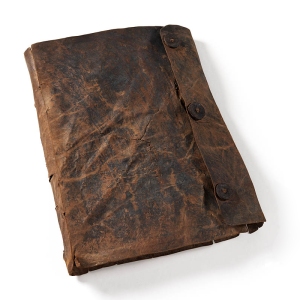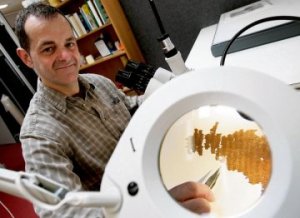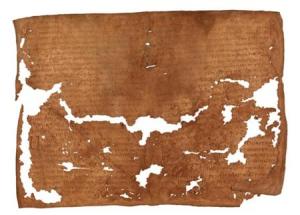Aidan O’Sullivan
It was one of the most astonishing Irish archaeological discoveries of modern times.
On a hot summer’s day in July 2006, a man working a mechanical excavator on a raised bog in Faddan More, Co. Tipperary uncovered – and saved until museum staff could reach it – a late-eighth century psalter, or book of psalms, that had been buried there centuries before. Perhaps amongst the most significant things about the Faddan More Psalter is not so much the text itself (which appears to be fairly conventional; would that it were a lost early Irish law tract or saint’s Life), but the materiality of the book itself.
The National Museum of Ireland’s staff of conservators, under the direction of Anthony Read, working with John Gillis who was seconded from TCD Library for the project, through an extraordinary feat of conservation and analysis (see Read 2011, below), have revealed that it was originally made of sixty sheets of calf vellum (produced through careful livestock management) gathered into five gatherings (or quires). Scientific analyses have revealed that it was inscribed with black-dark inks made of oak galls and decorated of pigments like orpiment, lamp black, red and white lead.
It was carried in a larger leather book cover, stiffened with papyrus, that had been manufactured for some other book, and this object itself evokes the humid heat of the Nile Delta, where warble flies buzzed around the ears of Coptic cattle. Emphasising the extraordinary character of the book’s very survival is the fact that in many cases, it was the inky letters themselves on the pages that preserved the vellum, whereas the rest of the pages were destroyed. Finally, the book and its cover were thrust down into a bog pool, together with a pig-skin bag and covered with a piece of white-haired calf hide.
It will probably always be a mystery to us why this book was hidden in a midlands bog; was it someone fleeing danger; carrying, hiding and ultimately losing a religious book? Or was it someone making an offering to the Lord, as is suggested by the deposition of other ecclesiastical treasures in watery places; seeking some redemption or placation, seeking protection from the dreary, wet climate of the Irish midlands in the eighth or ninth centuries AD?
Anyway, the Faddan More Psalter is now on exhibition in the National Museum of Ireland on Kildare Street, in the refurbished ‘An tSeodlann/The Treasury’. Overall the exhibition attempts to portray the achievements of artists, metalworkers and ecclesiastics from the late Iron Age through the ‘Golden Age’ of early medieval Ireland. It’s very professionally done and hopefully will attract plenty of international visitors, who will be fascinated, we hope, with this aspect of Ireland’s cultural heritage.
I’ve visited it several times now, initially on the first day of public access and subsequently with students and on other occasions on my own. You travel to the Faddan More Psalter by firstly entering through an arch into ‘An tSeodlann/The Treasury’ (where it is good to see some old friends back on display; the Broighter Hoard looks particularly well and you can now view the boat clearly from all sides).
The Faddan More room though, is really a new and very exciting exhibition about the advent of literacy in early Ireland, with the Psalter placed in the context of early writing, with a bilingual (i.e. with ogham and Roman lettering) ogham-inscribed pillar from Killeen Cormac, Co. Kildare (possible the site known as Cell Fine Cormaic, where according to the Vita Tripartita, one of the earliest missionaries to Ireland, Palladius, left his writing tablet, books and relics of SS Peter and Paul), bookshrines (including the Lough Kinale bookshrine), replica manuscripts, and a review of early medieval writing technologies (such as the Springmount bog, Ballyhutherland, Co. Antrim wax tablets, on which are written the Vulgate texts of Psalms 30-32).
Some of the ‘pages’ of the Faddan More Psalter itself will be periodically exhibited in the middle of the room (in a clever touch, you can view the ‘pages’ from both sides). You can also see the leather book cover or satchel on its own. There is plenty of other material too; including a short video (based on the excellent TV programme, which can be purchased as a DVD – which I’ve already used in undergraduate lectures); as well as a poster style display explaining the context and circumstances of the find and its conservation.
Perhaps, just perhaps, the architectural scale of the exhibition panels somewhat overwhelms the impact of the much smaller Psalter pages and its cover. I sat for a moment on one of the benches (always a nice touch to have places to sit down in museums…) and watched some visitors for a few minutes. Several people walked around the exhibition paying little regard to the Faddan More Psalter itself in the centre of the room and several stood reading the posters with their backs to the book cover and exhibited vellum pages. It seemed, well, wrong, somehow..it made the cover seem small, fragile..vulnerable. But of course, it is vulnerable, so I presume the large poster stand acts to protect the psalter pages further from light.
It is a fantastic exhibition though and an excellent addition to the National Museum of Ireland’s displays on early medieval Ireland. If you want to gain a sense of the power of the book, and the word, in the transformation of Ireland during the early Middle Ages, go and see it. There are also a range of publications to go with the exhibition. These are well-written, brilliantly illustrated and will undoubtedly travel the world themselves.
Read, A. 2011 The Faddan More Psalter: Discovery, Conservation and Investigation. National Museum of Ireland. Dublin





Pingback: OUT OF EGYPT
Pingback: OUT OF EGYPT - Irish Free Press | Irish Free Press
I’m so amazed by this story, thank you mabey someday I’ll get to go to IRELAND,a girl can dream..
Pingback: Box It, Bag It, Wrap It: Medieval Books on the Go | medievalbooks